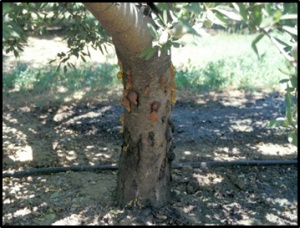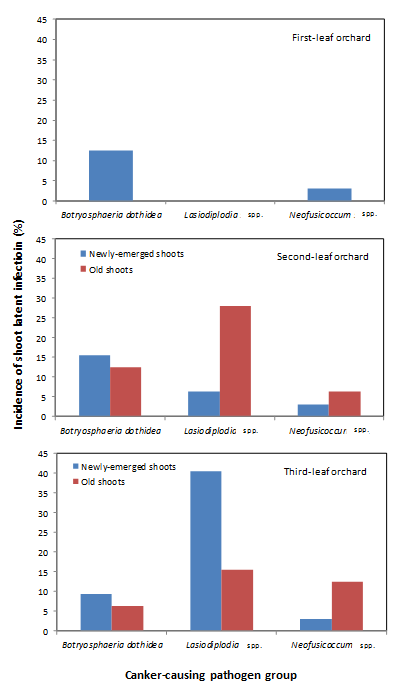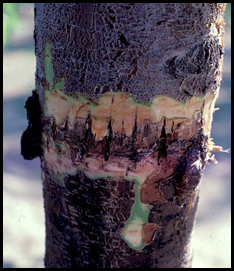Dani Lightle, UCCE Orchards Advisor, Glenn, Butte & Tehama Counties
Themis Michailides, UC Plant Pathology Specialist, Kearney Agricultural Research and Extension Center
Band canker has been an increasing problem in young almond orchards in recent years. Some hot spot areas in Glenn County have suffered high damage and occasionally required the replanting of an entire pollenizer variety. Symptomatic trees have gumming on the trunk. In the first year of infection, gumming may show as a ring or band around the trunk (hence its’ common name), though multiple years of infections can result in a gummy mess up and down the entire length of the trunk. Cankers do not necessarily extend entirely around the tree, nor are they limited to the trunk. Pruning wounds elsewhere on the tree can be a point of infection and bands of gum can also occur on primary scaffolds.

Tree showing band canker symptoms after infection events over multiple seasons. Photo: T. Michailiades.
Most cultivars can be infected by band canker, though certainly some are more susceptible than others. In my experience, Wood Colony seems to be extremely susceptible. Artificially inoculated trees developed the largest cankers in the Sonora, Carmel, Padre, and Nonpareil cultivars (Wood Colony was not tested). Trees are typically most susceptible from 4th – 6th leaf, though infections in 2nd and 3rd leaf orchards are becoming more common in recent years. There is a complex of Botryosphaeriaceae fungal species responsible for development of cankers. A handful of these species can also infect pistachio and walnut, while others infect almond but not the other tree nuts. The two most pathogenic species are Neofusicoccum nonquaesitum (a newly isolated species from almond) and N. parvum (also found in walnut and pistachio).
In past research, disease symptoms were associated with proximity to inoculum sources – an old walnut orchard, a riparian area with blackberries, eucalyptus groves – and/or irrigations wetting the trunks. However, I’m now observing orchards severely infected with band canker that are not located near typical inoculum sources and are on drip irrigation which maintains dry trunks. These observations have spurred new research by Dr. Themis Michailides, UC Plant Pathology Specialist, into what conditions have changed that are allowing for infection, and what management strategies can be implemented to help prevent severe infections.
What are the roles of latent infections in disease development? Latent infections are infections detectable in the plant without displaying the visual symptoms (in this case, cankers). In 2017, Dr. Yong Luo, a Postdoctoral Researcher in Dr. Michailides’ lab, did a survey of 1st leaf, 2nd leaf, and 3rd leaf orchards in Glenn County. Molecular tests on new shoots and 2 year-old shoots revealed that latent infections were detected in the three orchards sampled, including 1st leaf orchards. We also sampled shoots and cankers from symptomatic trees to see whether the species causing the latent infection was the same as the canker causing species – results are pending.

Percent of shoots with latent infections of three different canker-causing genera of fungi. Latent infections were found in 1st leaf orchards, and the incidence of latent infections continued to increase with orchard age.
Are shakers helping spread inoculum through an orchard? We sampled shaker pads from asymptomatic orchards, as well as immediately after shaking an infected tree. Two samples had very weak signals for Cytospora (sampled from the asymptomatic orchard) and Botryosphaeria dothidea (sampled from the symptomatic trees) while the remaining samples were all negative for all pathogens tested. These test results do not show strong evidence that shakers are responsible for spread of disease inoculum.
What preventative strategies can be undertaken? We will begin a fungicide trial this spring to evaluate materials that may help prevent or reduce the size and severity of cankers. In the meantime, keep water off trunks with stream splitters, moderate growth of young trees to prevent severe growth cracks that are a common entry point for infection, prevent damage and injury to the trunk from activities such as herbicide drift, and minimize pruning activities during key infection periods of March-May.



Leave a Reply